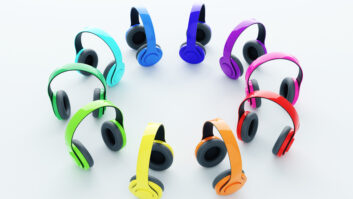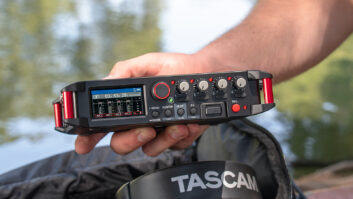Field Report: Neustar SW4.0
Oct 1, 2007 12:00 PM, By Rich Parker

Vermont Public Radio is Vermont’s only statewide public radio network. We broadcast two separate program services – news and information on five of our full service stations, and classical music on three stations. Both services have several supporting translators across the state, and we stream both services online 24 hours a day. With HD multicasting we are able to provide the classical music service on the HD-2 channel of all of our full service news and information stations, reaching those areas where we do not yet have a full service classical station in place.
When we first started looking into processing for HD Radio, the few existing software products were either not optimized for low bit-rate HD Radio multicast streams or couldn’t provide processing for multiple streams easily. The hardware products were not an option because of the substantial investment they presented in processing two multicast program streams for each of our eight full service HD stations. Multicasting on each of these signals could have required multiple devices for different types of programming on each stream.
During this investigation, we kept coming back to the Neural Neustar SW4.0 software. It became clear that by using the Neustar software directly on the HD Radio Importer we could maximize our multicasting capabilities beyond the two channels available using dedicated hardware. Also, as the requirements for physical space for HD Radio equipment in general has grown, this was an excellent way to minimize rack space needs and eliminate the need for another computer or outboard devices from having to be installed and configured.
Performance at a glance Software-based audio processor
HD Radio codec-specific feature set
User presets included
Software upgradable
Codec preconditioner and processor
USB port dongle for licensing
The flexibility of the SW4 to provide multiple channels of independent processing was also important to us as we investigated issues such as whether to have one or two supplemental services, and what a change to the higher bandwidth extended hybrid mode would mean in terms of streams available. A software-based processor allowed us to experiment with different settings without a new hardware investment. And of course, SW4 is certainly a cost savings over two or three independent hardware devices for that purpose.
Making trades
Low bit-rate audio is always a trade-off and a challenge, whether it is HD Radio multicasting or Web streaming. Digital artifacts, watery sounds, spectral anomalies � all the side effects we are used to hearing must be managed. To my ear, the SW4 software had the greatest capability to specifically address some of the more egregious problems in a simple and effective way.
The low bit-rate international news is delivered at 16kb/s. At this bit-rate, it is difficult to make it sound good because the source material is often already compromised � whether phone-quality sound from a distant place or multiple cascades of previously bit-reduced material. But we were able to make a palatable setting in SW4 that not only makes it intelligible, but overall very listenable. The smoothing function is perhaps the single most astonishing feature for enhancing this type of audio.
For our initial HD Radio multichannel broadcasts, we had a standard Neustar hardware unit for the HD1 channel and an Omnia 6EXi for our analog channel. We have an Aphex Compellor positioned before the STLs for the analog signal, which are connected to a Harris Flexstar Exciter. The SW4 was loaded directly on the Harris Importer, which feeds the Exporter for the two multicast channels. The audio fed into the Importer/SW4 is not pre-processed.
The final links in the HD Radio puzzle are our Harris transmitters � HT35K for analog, and the Mini-Z 2000 for digital and digital+analog FM backup for our biggest transmitter on Vermont’s highest peak, Mt. Mansfield. These feed a dual-port Shively panel antenna system that uses opposite ports on the antenna inputs for the analog and digital signals. We have several other solid state HD transmitters at our other sites around the state.

The various settings screens show a plethora of information.
The installation for the Neustar SW4.0 was fairly easy; the SW4 is runs on Windows XP on the Importer. There were a few issues to learn with the different paradigm for processing and some questions about whether to use virtual audio cable software or simply the available hardware channels on the Importer (which is what we ended up doing). But they were easily worked out with support from the Neural staff.
We have been running the Neustar SW4.0 since our HD Radio multicast in this market went on the air in December 2006. We are running an international news service on our HD3 channel at 16kb/s. We have been able to get a very respectable sound from that low bit-rate stream using the Neustar software. Our listeners who have access to HD Radio receivers find it very listenable. We also have a 32kb/s classical music stream on the HD2 channel, and it sounds very good. Our music hosts, who are usually critical of anything that isn’t quite right, have been impressed with how good it sounds at that lower bit rate.
Neural Audio P
W
E 425-814-3200
www.neuralaudio.com
[email protected]
The feedback we have received from our listeners touts how amazing multicasting is and how thrilled the listeners are to be able to receive multiple program streams on their new HD Radio receivers. We are committed to HD Radio, and are truly excited about all the opportunities to experiment with new formats. At VPR, we feel that the sky is the limit when it comes to multicasting.
Parker is director of engineering of Vermont Public Radio, Colchester, VT.
Editor’s note: Field Reports are an exclusive Radio magazine feature for radio broadcasters. Each report is prepared by well-qualified staff at a radio station, production facility or consulting company.
These reports are performed by the industry, for the industry. Manufacturer support is limited to providing loan equipment and to aiding the author if requested.
It is the responsibility of Radio magazine to publish the results of any device tested, positive or negative. No report should be considered an endorsement or disapproval by Radio magazine.







